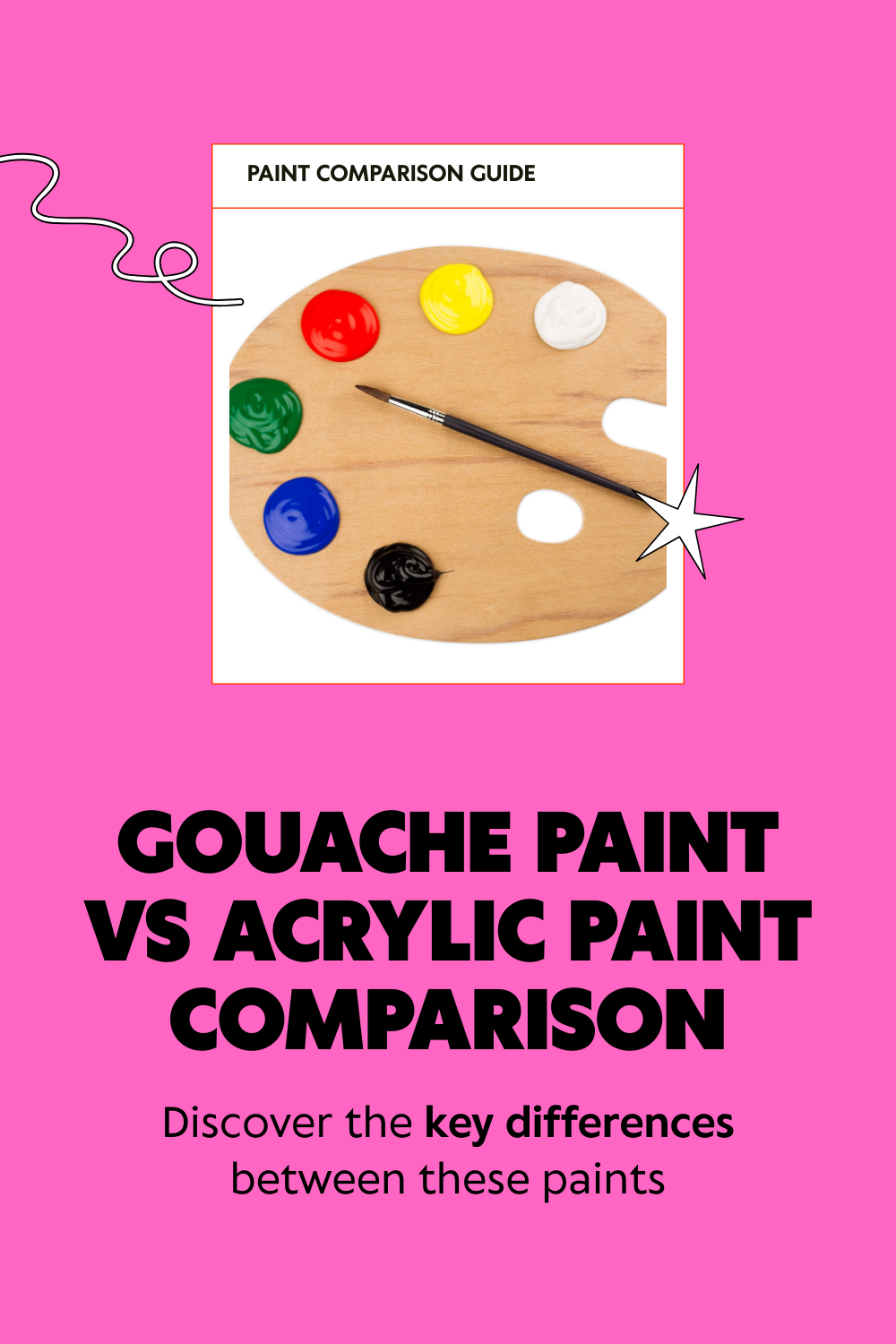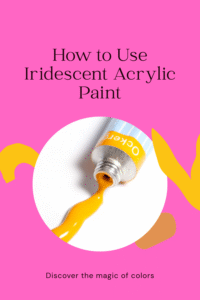If you’ve ever found yourself staring at the rows of colorful paints at your local art store, trying to figure out which one will best suit your next masterpiece, you’re not alone!
The two most commonly debated paints are gouache and acrylic. Both have their loyal followers, each swearing by their chosen medium. But as an artist, how do you choose between these two incredible paints?
In this article, I’ll break down the key differences between gouache and acrylic paint, covering everything from texture to versatility and usage.
Whether you’re a seasoned painter or just starting out, you’ll gain valuable insights into which paint is best suited to your artistic style. Let’s dive into this head-to-head comparison and help you make an informed decision for your next creative project!
Understanding the Basics: What is Gouache and Acrylic Paint?
Before we start comparing, let’s take a look at what makes these two paints unique.
Gouache Paint:
Gouache is a water-based paint that combines the properties of both watercolor and acrylic. It is made up of pigment, water, and a binding agent like gum arabic.
The finish of gouache paint is matte, and it dries quickly, making it ideal for layering and creating solid, opaque color. Gouache paints are usually used in fine art, illustration, and design.
Acrylic Paint:
Acrylic paint, on the other hand, is a fast-drying paint that consists of pigment suspended in an acrylic polymer emulsion. It’s highly versatile and can be used on a variety of surfaces like canvas, wood, paper, and even fabric.
Acrylics can be thinned with water, but once dried, they become water-resistant, making them excellent for long-lasting artwork. They offer vibrant colors and can be used to create both translucent and opaque effects.
Texture and Consistency
The texture of your paint significantly affects how it behaves on your canvas or paper. Let’s compare the textures of gouache and acrylic paint to help you understand the difference.
Gouache Texture:
Gouache paint has a creamy consistency that feels smooth when applied to surfaces. It’s more opaque than watercolor, making it great for solid color coverage without streaking.
Once applied, gouache retains its matte finish and doesn’t reflect light like acrylic does. It’s often praised for its velvety smooth feel, which allows for delicate layering.
Acrylic Texture:
Acrylic paint is more versatile when it comes to texture. It can be thickened to create impasto (a technique where paint is applied thickly for a 3D effect) or thinned with water or acrylic medium to give a watercolor-like effect.
Acrylics dry to a more polished, glossy finish, though they can be matte as well if you choose to add a matte medium to the paint. The texture can change dramatically depending on how you manipulate the paint, making it perfect for a variety of artistic effects.
Application and Usage
One of the most important factors when deciding between gouache and acrylic is how each paint applies to different surfaces and in different styles of painting.
Gouache Application:
Since gouache is water-based, you can re-wet the paint to achieve different textures and effects. It’s often used for fine detail work, illustrations, and even poster art.
Gouache is great for creating soft, smooth gradients or vibrant, solid colors. However, due to its matte finish, it can be challenging to achieve glossy effects without adding a gloss medium, which is not typically how gouache is used.
Acrylic Application:
Acrylic paint is incredibly versatile and works on a wide range of surfaces. You can apply it thinly to achieve a watercolor effect or build it up thickly for impasto-style painting.
Acrylics are fantastic for large-scale work due to their durability, and the paint remains vibrant even after drying.
It’s ideal for both beginners and experienced artists because it’s forgiving you can easily layer acrylic paint and correct mistakes, unlike gouache, which doesn’t allow for easy corrections once it’s dry.
Drying Time and Layering
Both gouache and acrylic paint dry quickly, but their behavior after drying differs significantly.
Gouache Drying Time:
Gouache dries rapidly, which can be an advantage when working on illustrations or needing to layer quickly. However, once dry, gouache is reactivated with water. This can be both a benefit and a downside it allows for easy corrections, but it can also cause previous layers to lift if you’re not careful.
Acrylic Drying Time:
Acrylic paints also dry quickly, but they don’t re-wet once dried. This means that once you paint a layer, it’s set. You can apply multiple layers quickly without worrying about disturbing the layer beneath.
If you want to achieve thicker textures, you may need to wait for each layer to dry before applying the next. While this offers great control over your artwork, it can be a little less forgiving if you make a mistake.
Durability and Maintenance
Durability is crucial when you want your art to last for years, especially if you’re painting on large canvases or creating works that will be exposed to different elements.
Gouache Durability:
Gouache can fade over time, especially if exposed to direct sunlight. Its matte finish also makes it susceptible to smudging and abrasion if not protected with a proper varnish. It’s generally not considered as durable as acrylic paint for long-lasting pieces.
Acrylic Durability:
Acrylic paint is known for its long-lasting durability. Once dried, acrylics are water-resistant, which means they won’t smudge or fade easily. This makes them ideal for artworks that will be exposed to environmental factors like humidity or sunlight. Many artists prefer acrylic for outdoor murals or pieces that need to stand the test of time.
Comparison Table: Gouache vs. Acrylic Paint
| Feature | Gouache | Acrylic |
| Texture | Creamy, smooth, matte finish | Versatile (can be smooth, textured, or glossy) |
| Drying Time | Dries quickly, reactivates with water | Dries quickly, permanent once dry |
| Application | Best for detail work and illustration | Versatile for large-scale or fine art |
| Layering | Can lift layers if re-wet | Can layer without disturbing previous layers |
| Durability | Prone to fading and smudging | Highly durable, water-resistant once dry |
| Best For | Illustrations, fine art, poster work | Large-scale work, mixed media, and texture-focused art |
Mistakes to Avoid When Using Gouache and Acrylic Paints
While both gouache and acrylic are wonderful mediums, there are some common mistakes that beginners and even seasoned artists often make.
Common Mistakes with Gouache:
- Not Using Enough Water:
Gouache needs to be mixed with water to get the best consistency. Many artists tend to use it straight from the tube, which can lead to an overly thick application. Make sure to thin the paint for smooth coverage. - Not Protecting the Finished Work:
Since gouache is prone to smudging and fading, it’s important to frame or protect your artwork with a spray fixative or varnish. This will ensure the longevity of your work.
Common Mistakes with Acrylic:
- Over-Thinning the Paint:
Acrylics are water-based, but over-thinning them can weaken the pigment’s color. To avoid this, use acrylic mediums designed to thin paint without compromising quality. - Not Letting Layers Dry Completely:
Acrylic paint dries quickly, but if you layer too soon, you risk lifting or muddying the colors. Always ensure that each layer is completely dry before adding more.
Conclusion:
Whether you choose gouache or acrylic paint ultimately depends on your artistic preferences and project needs. Gouache offers a smooth, opaque finish with the ability to re-wet and makes adjustments, which is ideal for detailed illustrations and fine art.
On the other hand, acrylics provide unmatched versatility and durability, making them perfect for large-scale works and experimental techniques.
Both paints have their advantages, and understanding the differences will help you choose the best medium for your next project.
Now, I’d love to hear your thoughts! Which one do you prefer, and why? Drop a comment below, share your experiences, or ask questions. And if you found this article helpful, don’t forget to share it with your fellow artists!
FAQs:
- Can gouache be used on canvas like acrylics?
Yes, you can use gouache on canvas, but it may not be as durable as acrylic paint. It is more prone to smudging and fading, so a protective finish is recommended. - Can you mix gouache and acrylic paint?
Mixing gouache and acrylic can be tricky, but it is possible. Acrylics tend to be more durable and water-resistant, while gouache is more rewettable. Be cautious when layering them, as gouache may lift the acrylic beneath. - Is gouache paint suitable for beginners?
Yes, gouache is a fantastic choice for beginners due to its vibrant colors and ability to work with different techniques. Just remember to work in layers and keep the paint moist to avoid cracking.



